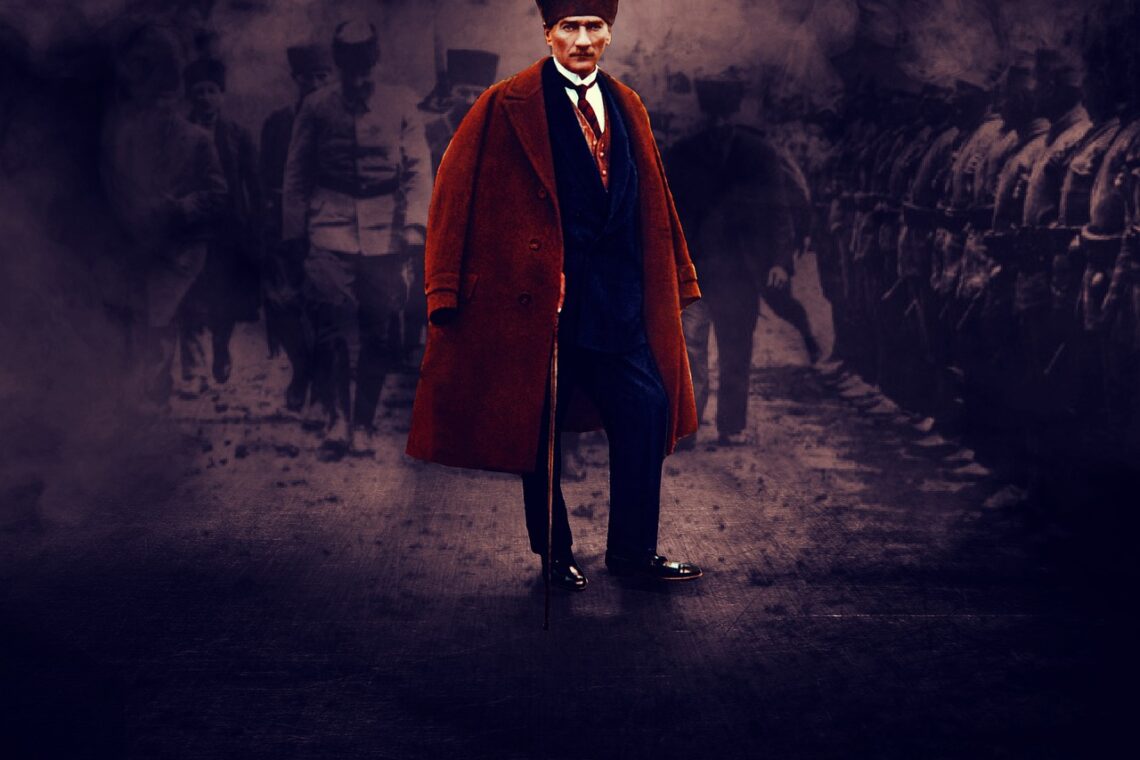Mustafa Kemal Atatürk, the founder and first president of the Republic of Turkey, was born in 1881 in a three-story pink house on Islâhhâne Street in the Kocakasım neighborhood of Thessaloniki. His father was Ali Rıza Efendi, and his mother was Zübeyde Hanım. On his father’s side, his grandfather Hafız Ahmet Efendi belonged to the Kocacık Yörüks, who were settled in Macedonia from Konya and Aydın in the 14th-15th centuries. His mother, Zübeyde Hanım, was the daughter of an old Turkish family that had settled in the town of Langaza near Thessaloniki. Ali Rıza Efendi, who served as a militia officer, a clerk in the religious foundation office, and a timber trader, married Zübeyde Hanım in 1871. Out of Atatürk’s five siblings, four passed away at a young age, and only Makbule (Atadan) lived until 1956.
Young Mustafa started his education at the neighborhood school of Hafız Mehmet Efendi and later transferred to Şemsi Efendi School at his father’s request. During this time, his father passed away in 1888. After staying with his uncle at Rapla Farm for a while, he returned to Thessaloniki and completed his education. He enrolled in Selânik Mülkiye Rüştiyesi (civil preparatory school). Shortly after, in 1893, he entered the Military Preparatory School. It was during this time that he added “Kemal” to his name in honor of his mathematics teacher, Mustafa Bey.
He graduated from Manastır Military High School in 1899 and began his education at the Ottoman Military Academy in Istanbul. In 1902, he graduated as a lieutenant and continued his studies at the Military Academy. On January 11, 1905, he completed the Academy with the rank of captain. Between 1905 and 1907, he served in the 5th Army in Damascus. In 1907, he became a Kolağası (Senior Captain) and was assigned to the III. Army in Manastır. On April 19, 1909, he served as the Chief of Staff in the Army of Action that entered Istanbul. In 1910, he was sent to France and participated in the Picardie Maneuvers. In 1911, he began working at the General Staff in Istanbul.
During the war that began with the Italian invasion of Tripolitania in 1911, Mustafa Kemal, along with a group of friends, participated in operations in the Tobruk and Derna regions. On December 22, 1911, he won the Battle of Tobruk against the Italians. On March 6, 1912, he was appointed the Commander of Derna.
When the Balkan War began in October 1912, Mustafa Kemal joined the fight with units stationed in Gallipoli and Bolayır. He played a significant role in the recapture of Dimetoka and Edirne. In 1913, he was appointed as the Military Attaché in Sofia. During this assignment, in 1914, he was promoted to the rank of major. His duties as the Military Attaché ended in January 1915. Meanwhile, World War I had started, and the Ottoman Empire was forced to join the war. Mustafa Kemal was assigned to Tekirdağ to establish the 19th Division.
In World War I, which began in 1914, Mustafa Kemal created a heroic epic at Gallipoli, declaring “Çanakkale is impassable!” to the Allied Forces. On March 18, 1915, when the British and French navies attempted to pass through the Dardanelles, they suffered heavy losses, leading to their decision to land troops on the Gallipoli Peninsula on April 25, 1915. The enemy forces that landed at Arıburnu were halted by the 19th Division, commanded by Mustafa Kemal, at Conkbayırı.
This success earned him the rank of colonel. The British launched another attack on August 6-7, 1915, at Arıburnu. Commander of the Anafartalar Group, Mustafa Kemal, achieved victory in the Battle of Anafartalar on August 9-10. This was followed by the victories at Kireçtepe on August 17 and in the Second Battle of Anafartalar on August 21. The Turkish nation, which suffered about 253,000 casualties in the Battle of Gallipoli, successfully preserved its honor against the Allied Powers. Mustafa Kemal’s order to his soldiers, “I am not ordering you to attack, I am ordering you to die,” changed the course of the frontlines.
After the Gallipoli Campaign, Mustafa Kemal served in Edirne and Diyarbakır in 1916. On April 1, 1916, he was promoted to the rank of brigadier general. He played a significant role in the recapture of Muş and Bitlis by fighting against Russian forces. After brief assignments in Damascus and Aleppo, he returned to Istanbul in 1917. He traveled to Germany with Crown Prince Vahidettin Efendi to observe the frontlines. Following this trip, he fell ill.
He received treatment in Vienna and Karlsbad. On August 15, 1918, he returned to Aleppo as the Commander of the 7th Army. He conducted successful defensive battles against British forces in this region. One day after the signing of the Armistice of Mudros, on October 31, 1918, he was appointed as the Commander of the Yıldırım Army Group. After the dissolution of this army group, he arrived in Istanbul on November 13, 1918, and took office at the Ministry of War.
With the onset of the Allied Powers’ occupation of Ottoman territories following the Armistice of Mudros, Mustafa Kemal arrived in Samsun on May 19, 1919, as the Inspector of the 9th Army. On June 22, 1919, he issued a proclamation in Amasya declaring that “the nation’s independence will be saved by the nation’s determination and will” and called for the convening of the Sivas Congress. Holding the Erzurum Congress between July 23 and August 7, 1919, and the Sivas Congress from September 4 to 11, 1919, he laid the groundwork for the nation’s liberation.
He was warmly welcomed in Ankara on December 27, 1919. On April 23, 1920, the opening of the Grand National Assembly of Turkey marked a significant step towards the establishment of the Republic of Turkey. Mustafa Kemal was elected as the head of both the Assembly and the Government. The Grand National Assembly of Turkey enacted and implemented the necessary laws for the success of the War of Independence.
The Turkish War of Independence began on May 15, 1919, when the Greeks occupied İzmir. Initially, the war was fought with the forces of the Kuva-yi Milliye, which were later integrated into the regular army. The Grand National Assembly of Turkey established a regular army and integrated the Kuva-yi Milliye, leading to the successful outcome of the war.
The important stages of the Turkish War of Independence under the leadership of Mustafa Kemal are as follows:
- Liberation of Sarıkamış (September 20, 1920), Kars (October 30, 1920), and Gümrü (November 7, 1920).
- Defenses of Çukurova, Gaziantep, Kahramanmaraş, and Şanlıurfa (1919-1921).
- First Battle of İnönü (January 6-10, 1921).
- Second Battle of İnönü (March 23 – April 1, 1921).
- Battle of Sakarya (August 23 – September 13, 1921).
- Great Offensive, Grand Commander Battle, and Great Victory (August 26 – September 9, 1922).

Following the Battle of Sakarya, on September 19, 1921, the Grand National Assembly of Turkey bestowed the title of Marshal and the honorific “Gazi” on Mustafa Kemal. The War of Independence concluded with the signing of the Treaty of Lausanne on July 24, 1923. This marked the establishment of the new Turkish state, based on national unity, on the territories of modern Turkey, which had been fragmented by the Treaty of Sèvres, leaving only 5-6 provinces for the Turks.
On April 23, 1920, the opening of the Grand National Assembly of Turkey in Ankara heralded the establishment of the Republic of Turkey. The successful management of the War of Independence by the Assembly hastened the creation of the new Turkish state. On November 1, 1922, the caliphate and the sultanate were separated, and the sultanate was abolished. Thus, the ties to the Ottoman Empire’s rule were severed.
On October 13, 1923, the Republican regime was adopted, and Atatürk was unanimously elected as the first president. On October 30, 1923, İsmet İnönü formed the first government of the Republic. The Republic of Turkey began to rise on the foundations of “Sovereignty belongs unconditionally to the nation” and “Peace at home, peace in the world.”
With the aim of raising Turkey to the level of contemporary civilizations, Atatürk implemented a series of reforms. These reforms can be grouped under five headings:
- Political Reforms:
- Abolition of the Sultanate (November 1, 1922).
- Proclamation of the Republic (October 29, 1923).
- Abolition of the Caliphate (March 3, 1924).
- Social Reforms:
- Granting equal rights to women (1926-1934).
- Hat and clothing reform (November 25, 1925).
- Closure of dervish lodges and tombs (November 30, 1925).
- Adoption of surnames (June 21, 1934).
- Abolition of titles and honorifics (November 26, 1934).
- Adoption of international time, calendar, and measurement standards (1925-1931).
- Legal Reforms:
- Abolition of the Mecelle (Islamic legal code) (1924-1937).
- Introduction of the Turkish Civil Code and other laws to establish a secular legal system (1924-1937).
- Education and Cultural Reforms:
- Unification of education (March 3, 1924).
- Adoption of the new Turkish alphabet (November 1, 1928).
- Establishment of Turkish Language and History Institutions (1931-1932).
- Reformation of university education (May 31, 1933).
- Innovations in the fine arts.
- Economic Reforms:
- Abolition of tithe (Aşar).
- Encouragement of farmers.
- Establishment of model farms.
- Introduction of the Industry Encouragement Law and establishment of industrial facilities.
- Implementation of the First and Second Development Plans (1933-1937) to modernize the country’s infrastructure.
As per the Surname Law, on November 24, 1934, the Grand National Assembly of Turkey granted Mustafa Kemal the surname “Atatürk.”
Atatürk served as the President of the Grand National Assembly on April 24, 1920, and August 13, 1923. This presidency was at the level of Head of State and Government. On October 29, 1923, the Republic was proclaimed, and Atatürk was elected as the first president. Therefore, according to the Constitution, presidential elections were held every four years. He was re-elected as President by the Grand National Assembly in 1927, 1931, and 1935.
Atatürk conducted frequent nationwide tours to oversee state activities on-site. So, he issued orders to relevant authorities for areas that needed improvement. Meanwhile, as the President, he hosted foreign heads of state, prime ministers, ministers, and military commanders who visited Turkey. So, on October 15-20, 1927, he delivered a monumental speech recounting the Turkish War of Independence and the establishment of the Republic. On October 29, 1933, he delivered the 10th Anniversary Speech.
Atatürk lived a simple life in his personal life. On January 29, 1923, he married Latife Hanım. They embarked on numerous trips together. The marriage lasted until August 5, 1925. Atatürk had a great love for children. He adopted Afet (İnan), Sabiha (Gökçen), Fikriye, Ülkü, Nebile, Rukiye, and Zehra as his spiritual daughters, as well as a shepherd named Mustafa as his spiritual son.

He took custody of Abdurrahim and İhsan, two children in need. He donated his estates to the treasury, and some properties to the Ankara and Bursa municipalities in 1937. He allocated shares from his inheritance to his sister, spiritual children, and the Turkish Language and History Institutions. He had a rich library collection and was fluent in French and German. He enjoyed reading, listening to music, dancing, horseback riding, and swimming. He had a stron
g interest in traditional Turkish folk dances, wrestling, and folk songs from the Balkans. He found pleasure in playing backgammon and billiards. So, he valued his horse named Sakarya and his dog named Fox. He established the Atatürk Forest Farm and participated in its activities. Then, he traveled often to the farm to actively participate in its operations.
Atatürk passed away on November 10, 1938, at 9:05 am due to cirrhosis. Afterwhile, he breathed his last in the Dolmabahçe Palace in Istanbul. His funeral took place on November 21, 1938, and he was temporarily laid to rest in the Ankara Ethnography Museum.

